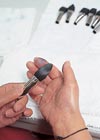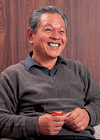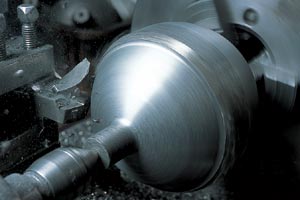|
|
||||||||||||||||||||||||||||||||||||||||
Cutting a Perfect Shot by Ear and Hand
Tsujitani Industries
Written by Torikai Shin-ichi, Photos by Kono Toshihiko
A lump of cast iron is spinning quickly on the lathe. I'm at a factory in Fujimi, Saitama Prefecture, where Tsujitani Masahisa is focusing all of his attention on his ears, distinguishing the sound of the iron being chiseled from the racket made by the motor. He slowly moves the handle to change the angle of the blade. He's not looking at the iron ball being formed—he's relying on the sound. The lump of iron will become a shot to be used in the competitive sport of shot putting.
"To make a shot with a perfectly balanced center of gravity, we rely on sound, not sight."
Shots are made from cast iron. When the molten iron begins to harden, the lower part becomes denser. The shot's center of gravity should be right in the center, so the denser (heavier) part has to be chiseled away more than the less dense (lighter) part. Even the latest computer-controlled lathe cannot do this properly. Tsujitani listens to subtle changes in sound to decide how much to chisel off. "The lighter part has a softer sound," he says.
Tsujitani's superior manufacturing technique was obvious during the 2000 Olympic Games in Sydney, when all 12 shot putters left in the men's final round chose his shots from among the various brands available to them.
|
||||||||||||||||||||||||||||||||||||||||




